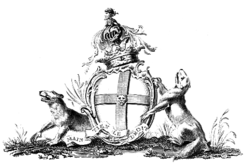- Duke of Chandos
-
The title Baron Chandos has been created twice in the Peerage of England. It was first created in 1337 when Roger de Chandos was summoned to parliament. It became extinct on his death.
It was next created, with the precise form "Baron Chandos, of Sudeley in the county of Gloucester", in 1554 for John Brydges, formerly MP for Gloucestershire. The three succeeding barons were all Members of Parliament and persons of some importance — see particularly Grey, 5th Baron, and his elder son George, 6th Baron. George had six daughters but no sons, and after the death of his brother William in 1676 the barony came to a kinsman, Sir James Brydges, Bart., who was English ambassador to Istanbul from 1680 to 1685. The eighth baron's son, also James Brydges, was to become 1st Duke of Chandos. He was created Earl of Carnarvon (second creation) in 1714 and Duke of Chandos in 1719. Subsidiary titles included Marquess of Carnarvon (1719) and Viscount Wilton (1714). All of these titles were in the Peerage of Great Britain. The 1st Duke built an exceptionally grand country house called Cannons that, though it was parodied in his lifetime, was a seat of great learning and culture: Handel was the resident composer from 1717 until 1719. Cannons House was demolished by the second duke.
With the death of the third duke in 1789, the titles became extinct, and the barony became dormant. An attempt was made by Samuel Egerton Brydges to claim the barony, initially on behalf of his older brother Revd Edward Tymewell Brydges and then on his own behalf. Litigation lasted from 1790 to 1803 before the claims were rejected, but Egerton Brydges continued to style himself per legem terrae Baron Chandos of Sudeley. It seems likely that not only was the claim groundless but that the evidence was forged.
Contents
Barons Chandos, first creation (1337)
- Roger de Chandos, 1st Baron Chandos (d. 1353) was probably 1st Lord Chandos.
- Thomas Chandos, 2nd Baron Chandos (Claimant)
- John Chandos, 3rd Baron Chandos (Claimant)
Most sources read that the title went extinct upon the death of the 1st Lord, although other include a 2nd and 3rd Lord (his son and grandson) before the title went extinct. The presumed 2nd Lord Chandos was High Sheriff of Herefordshire for 1359, 1370 and 1372 and the presumed 3rd Lord Chandos served the same office for 1382.
Barons Chandos, second creation (1554)
- John Brydges, 1st Baron Chandos (1492–1557) is sometimes listed as de jure 7th Lord Chandos of the 1337 creation[1]
- Edmund Brydges, 2nd Baron Chandos (bef. 1522–1573) eldest son of the 1st Baron
- Giles Brydges, 3rd Baron Chandos (1548–1594), elder son of the 2nd Baron, died without male issue
- William Brydges, 4th Baron Chandos (c. 1552–1602), younger son of the 2nd Baron
- Grey Brydges, 5th Baron Chandos (c. 1581–1621), only son of the 4th Baron
- George Brydges, 6th Baron Chandos (1620–1655), elder son of the 5th Baron, died without male issue
- William Brydges, 7th Baron Chandos (d. 1676), younger son of the 5th Baron, died without male issue
- James Brydges, 8th Baron Chandos (1642–1714), great-great-grandson of the 1st Baron
- James Brydges, 9th Baron Chandos (1674–1744) (created Earl of Carnarvon in 1714 and Duke of Chandos in 1719)
Dukes of Chandos (1719)
- James Brydges, 1st Duke of Chandos (1674–1744), eldest son of the 8th Baron
- John Brydges, Marquess of Carnarvon (1703–1727), elder son of the 1st Duke, died without male issue
- Henry Brydges, 2nd Duke of Chandos (1708–1771), younger son of the 1st Duke
- James Brydges, 3rd Duke of Chandos (1731–1789), only son of the 2nd Duke, died without male issue. The barony went either abeyant, dormant or extinct and the other titles extinct.
- The 3rd Duke's son-in-law, the 2nd Marquess of Buckingham, was created Duke of Buckingham and Chandos in 1822.
External links
References
 This article incorporates text from a publication now in the public domain: Chisholm, Hugh, ed (1911). Encyclopædia Britannica (11th ed.). Cambridge University Press.
This article incorporates text from a publication now in the public domain: Chisholm, Hugh, ed (1911). Encyclopædia Britannica (11th ed.). Cambridge University Press.- The Gentleman's Magazine 162 (1837) pp.534–535.
Categories:- Dukedoms of England
- Extinct British dukedoms
Wikimedia Foundation. 2010.

